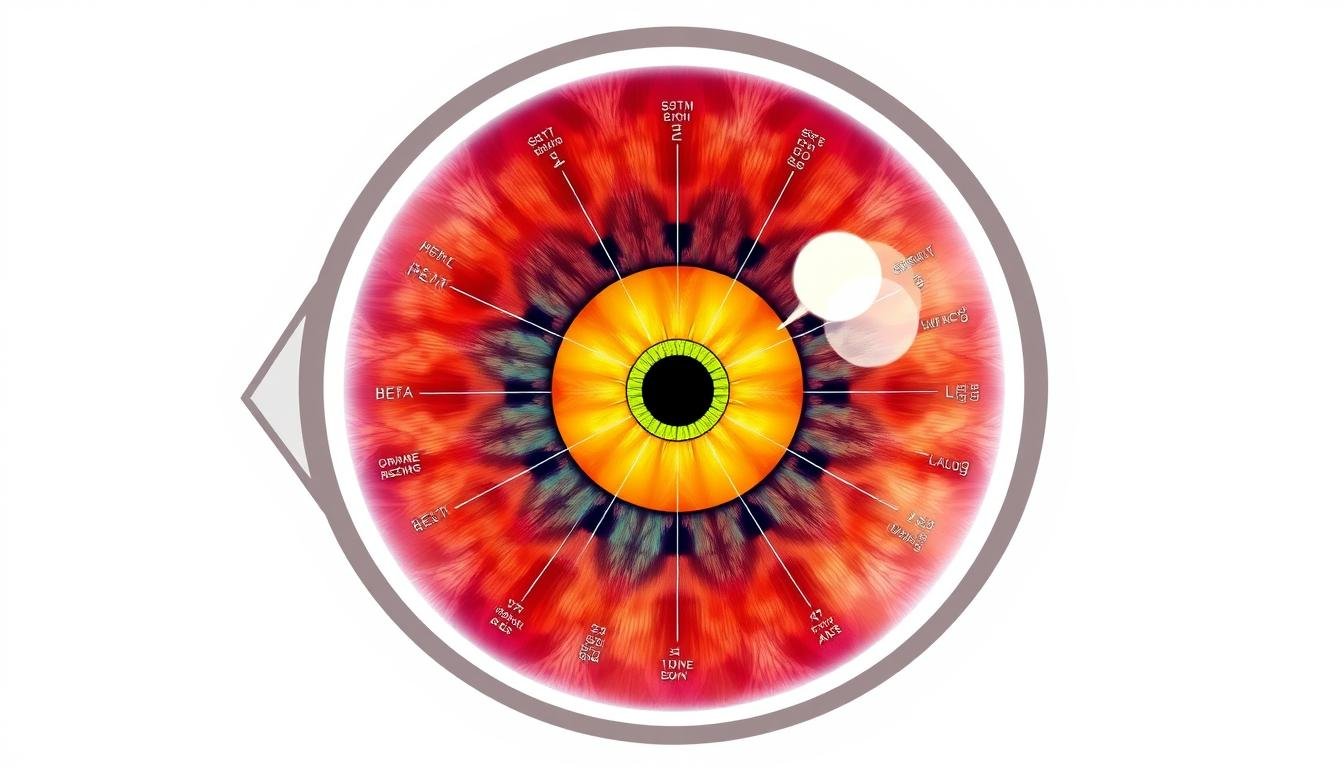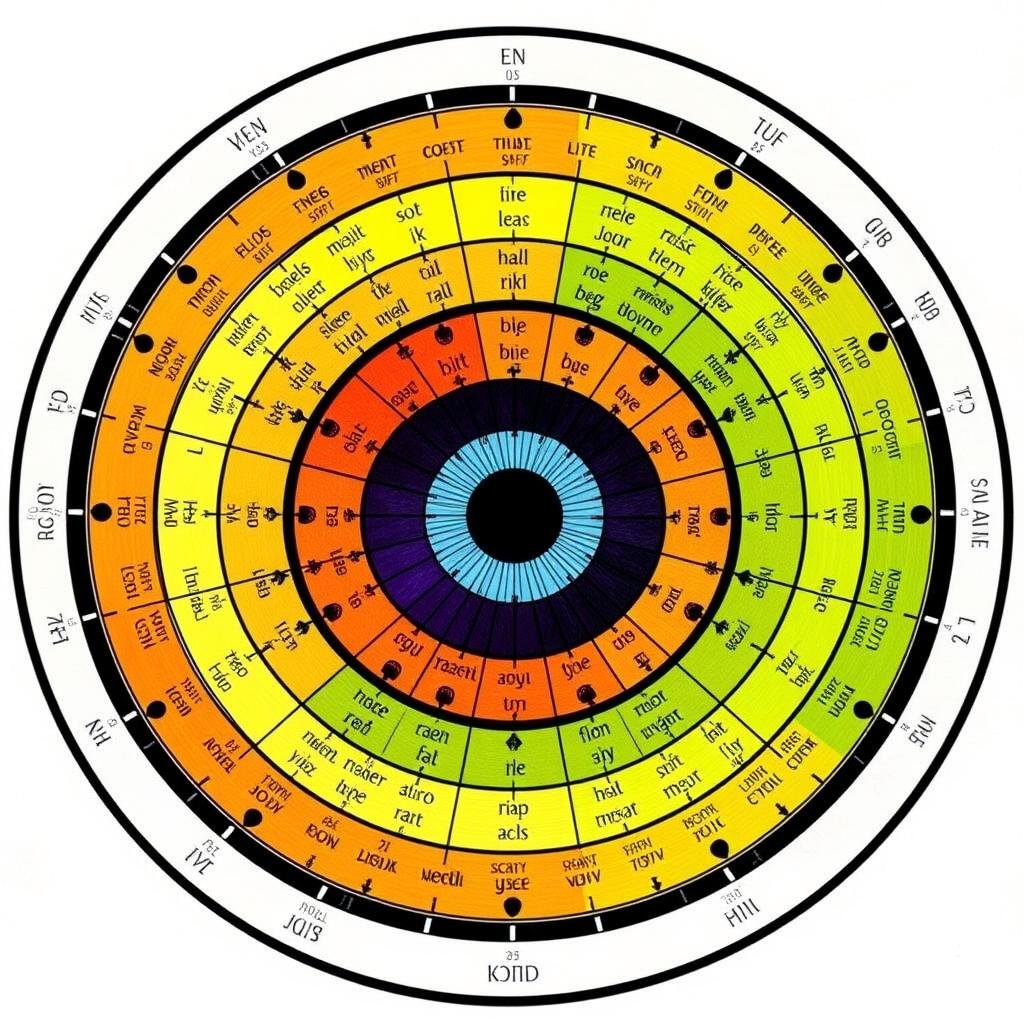The human iris, with its intricate patterns and unique coloration, has fascinated health practitioners for centuries. Many believe these patterns hold secrets to our overall health. Diagrame de iridologie claim to map the iris to different body systems, suggesting that changes in the colored part of your eye can reveal health conditions developing elsewhere in your body. But can these colorful maps really detect disease, or is this practice more myth than medicine? This comprehensive guide explores the fascinating world of iridology, separating scientific facts from popular claims.


Ce este un Diagrama de iridologie?
Un diagramă de iridologie is a detailed map that divides the iris—the colored part of your eye—into zones that supposedly correspond to different organs and systems throughout the body. Practitioners of iridology use these charts as reference tools to analyze patterns, colors, and markings in your iris to assess your health status and potential areas of concern.
These charts typically divide the iris into multiple sections, similar to slices of a pie. Each section is believed to represent different parts of the human body. For example, the top section might represent the brain and head, while the lower sections might correspond to the digestive system or reproductive organs.
Different diagrame de iridologie may vary in their exact mappings, but most follow similar principles in connecting specific iris regions to bodily systems. The right iris is generally associated with the right side of the body, while t
 he left iris corresponds to the left side.
he left iris corresponds to the left side.
History of Diagrame de iridologie
The concept of iridology dates back to the 17th century, but it was Hungarian physician Ignatz von Peczely who is often credited with developing the first formal diagramă de iridologie in the 1800s. According to legend, as a child, von Peczely noticed changes in an owl’s iris after the bird suffered a broken leg. This observation sparked his lifelong study of the relationship between iris markings and physical health.
By the early 20th century, iridology had spread throughout Europe and eventually to North America. Different schools of thought emerged, each with their own variations of iris charts and interpretation methods. Today’s diagrame de iridologie are the result of these evolving traditions, combining historical observations with more recent adaptations.
Cum Diagrame de iridologie Work
Iridologists use specialized equipment to examine the iris in detail, comparing their observations to an diagramă de iridologie. The process typically involves these steps:
- The iridologist takes high-resolution photographs of both irises
- These images are examined using magnification tools
- The practitioner identifies markings, colors, and patterns in the iris
- These observations are compared to an diagramă de iridologie
- The iridologist provides an assessment based on these comparisons

Curios despre ceea ce dezvăluie irisul tău?
Our certified iridologists use advanced imaging technology to analyze your iris patterns and provide personalized insights about your health.
Schedule Your Iris Analysis
Common Myths About Diagrama de iridologie Diagnostic
Despite its popularity in alternative medicine circles, iridology is surrounded by several misconceptions. Let’s examine some common myths about what diagrame de iridologie can actually reveal:
What Iridology Claims
- Iridology can diagnose specific diseases
- Changes in the iris directly reflect current health conditions
- All body systems can be accurately mapped on the iris
- Iridology can predict future health problems
- One iris examination provides complete health information
The Reality
- Iridology cannot diagnose specific diseases
- Many iris features are genetic or permanent
- Scientific evidence for organ-iris connections is limited
- Predictive capabilities are not scientifically validated
- Comprehensive health assessment requires multiple approaches
One of the most persistent myths is that diagrame de iridologie can be used to diagnose specific diseases like cancer or diabetes. In reality, even dedicated practitioners acknowledge that iridology is not a diagnostic tool but rather a method for identifying areas of potential stress or weakness in the body.

Can iridology detect cancer or serious diseases?
No, iridology cannot detect or diagnose specific diseases like cancer. While practitioners may identify areas of potential stress in body systems, iridology should never replace conventional medical diagnosis for serious conditions. Scientific studies have not supported claims that iris patterns can reliably indicate specific diseases.
Do changes in the iris reflect immediate health changes?
Most iris features are either genetic or develop over long periods. The iris typically doesn’t change rapidly in response to acute health conditions. While some practitioners claim to observe changes, these observations haven’t been consistently verified in controlled studies.
Scientific Facts and Limitations of Iridology
When examining iridology from a scientific perspective, it’s important to understand both the research that has been conducted and the current medical consensus on this practice.
Research on Diagrama de iridologie Accuracy
Several scientific studies have investigated the claims made by iridology practitioners:
| Study |
An |
Findings |
| Journal of the American Medical Association |
1979 |
Iridologists could not detect kidney disease in patients when examining photographs of irises |
| British Medical Journal |
1988 |
Iridologists failed to identify patients with gallbladder disease |
| Australian Journal of Optometry |
2005 |
No correlation found between iris signs and confirmed medical diagnoses |
The scientific community generally considers iridology to lack sufficient evidence to support its use as a health assessment tool. Most medical professionals point to several key limitations:
Key Limitations of Iridology:
- Lack of standardization across different diagrame de iridologie and schools of practice
- Absence of a clear physiological mechanism to explain how internal organs would affect iris appearance
- Poor performance in controlled clinical trials
- Potential for delayed proper medical treatment if relied upon exclusively

Case Studies and Expert Opinions
Despite the lack of scientific validation, many practitioners and patients report positive experiences with iridology. Let’s examine some perspectives from both sides of the debate.
Practitioner Perspective
Many iridologists report success in identifying areas of concern that later manifest as health issues. They argue that the diagramă de iridologie serves as a valuable tool for preventive health, allowing them to suggest lifestyle changes before symptoms appear.
“I’ve been practicing iridology for over 20 years and have seen remarkable correlations between iris signs and my clients’ health conditions. While it’s not diagnostic, it provides valuable insights that complement other health assessments.”
– Maria Chen, Certified Iridologist
Medical Perspective
Most medical doctors and researchers remain skeptical about iridology’s claims. They point to the lack of physiological mechanism and poor performance in controlled studies as reasons to approach iridology with caution.
“While the iris can reveal certain health conditions like diabetes-related changes, the specific mappings used in iridology charts lack scientific validation. Patients should not rely on iridology in place of evidence-based medical care.”
– Dr. James Wilson, Ophthalmologist

Notă importantă: If you’re interested in exploring iridology, consider it as a complementary approach rather than a replacement for conventional medical care. Always consult with qualified healthcare providers for diagnosis and treatment of medical conditions.
Explore Iridology With Professional Guidance
Our certified practitioners combine traditional iridology knowledge with modern health approaches for a holistic view of your wellbeing.
Book A Consultation Today
Alternatives to Diagrama de iridologie Analiză
If you’re interested in holistic health assessment, several evidence-based alternatives exist that can complement or replace iridology:

Functional Medicine Testing
Comprehensive blood panels, stool analysis, and other laboratory tests can provide objective data about your body’s functioning. These tests are scientifically validated and can detect imbalances before symptoms appear.

Traditional Assessment Methods
Practices like Traditional Chinese Medicine and Ayurveda offer systematic approaches to health assessment based on centuries of observation. These include tongue diagnosis, pulse reading, and constitutional analysis.

Lifestyle Analysis
A thorough review of diet, sleep, stress, and exercise patterns can reveal much about your health status. Many health practitioners focus on these fundamental factors as the foundation of wellbeing.
When considering any health assessment method, it’s important to evaluate the evidence supporting its use. Look for approaches that have been studied scientifically and have demonstrated reliable results. Remember that the most effective health strategies often combine insights from multiple assessment methods.
Health Warning: Never delay seeking conventional medical care for serious symptoms based on iridology or any alternative assessment. Early diagnosis and treatment of serious conditions can be life-saving.
Concluzie: Locul de Diagrame de iridologie in Health Assessment
The human iris is undeniably fascinating—unique as a fingerprint and visually striking. Diagrame de iridologie attempt to connect this intricate structure to our overall health in ways that intrigue many seeking holistic understanding of their bodies.
While scientific evidence doesn’t currently support many claims made about iridology, this doesn’t necessarily mean the practice is without any value. For some, iridology serves as an entry point to greater health awareness and preventive practices. Others find value in the holistic perspective it offers, considering the body as an interconnected system rather than isolated parts.
If you choose to explore iridology, approach it with informed curiosity. Consider it as one perspective among many, rather than a definitive assessment of your health. Most importantly, maintain regular check-ups with healthcare providers who use evidence-based methods for diagnosis and treatment.


























